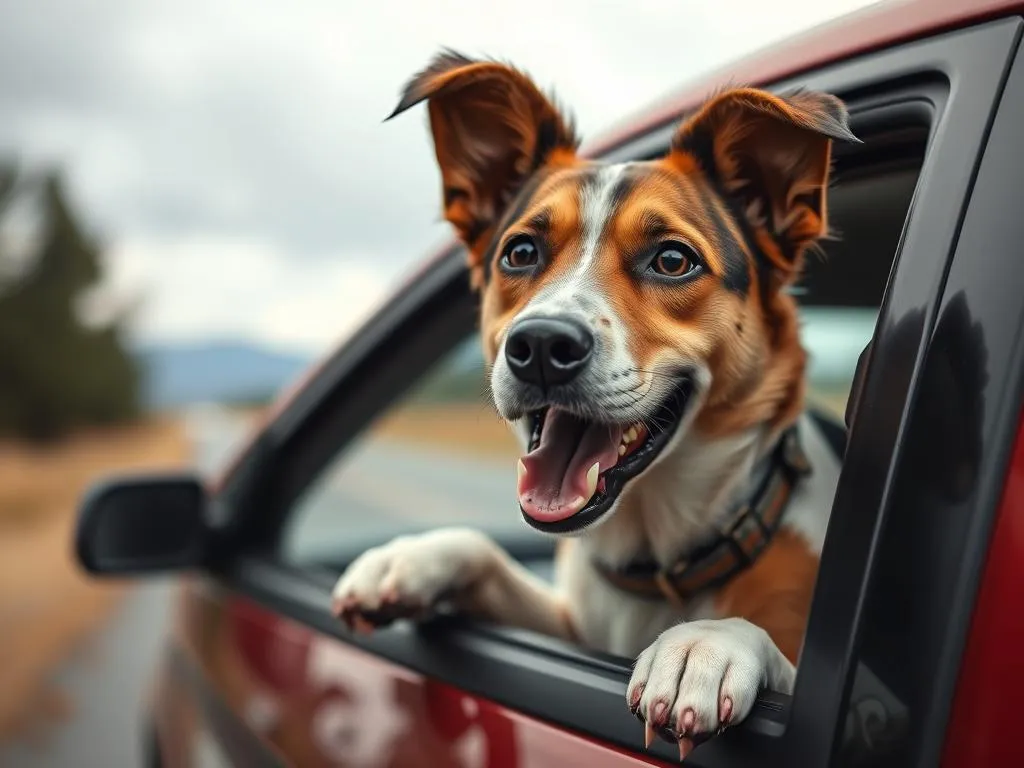
Car rides can be one of the most exhilarating experiences for a dog. The rush of wind against their fur, the symphony of new scents, and the thrill of adventure all combine to create a joyous ride. It’s no wonder you often see dogs with their heads hanging out of car windows, tongues flapping in the breeze. This behavior, while endearing, raises questions about what drives our canine companions to seek out this experience. Understanding why dogs stick their head out of car windows not only deepens our appreciation for their instincts but also highlights important health and safety considerations.
The Joy of the Ride
Sensory Stimulation
Dogs experience the world in ways that are vastly different from humans. Their sense of smell is estimated to be between 10,000 to 100,000 times more sensitive than ours. This means that every car ride for your dog is a sensory explosion. As they stick their heads out of the window, they are bombarded with a myriad of scents that shift as the car moves. From the smell of freshly cut grass to that of a nearby bakery, each scent tells a story.
The wind carries these scents to your dog, enhancing their experience. In fact, the combination of the rushing wind and the changing aromas can stimulate their brain, making them feel more alive and engaged with their environment. For many dogs, this is pure ecstasy, and it’s easy to see why they can’t resist sticking their heads out to fully embrace this sensory feast.
The Thrill of Adventure
For dogs, car rides often symbolize adventure. Many dogs associate getting into a car with exciting outings — trips to the park, visits to friends, or even vacations. This instinct for exploration is deeply ingrained in many breeds, harking back to their wild ancestors who roamed vast territories. Sticking their heads out of the window allows them to partake in the thrill of the journey, feeling like they are part of the adventure.
Moreover, the excitement of seeing new sights can be invigorating. Dogs are naturally curious creatures, and the ability to see the world rushing by adds to their excitement. When they see passing cars, people, and landscapes, they are essentially participating in a dynamic environment that fuels their innate desire to explore.
Behavioral Insights
Canine Instincts
The behaviors we observe in our dogs today are often influenced by their genetic history. Many dogs, especially working breeds, have an instinctual drive to explore their surroundings. This innate curiosity drives them to seek new experiences, which is why sticking their heads out of the car window feels so rewarding.
In the wild, a dog’s ancestors would need to navigate their environment to find food, mates, or safe havens. This instinct remains strong, manifesting in modern dogs as a need to explore. When they stick their heads out of the window, they are tapping into this primal urge, feeling as though they are part of the wider world beyond the confines of the car.
Social Behavior
Dogs are social animals, and their bond with humans shapes a lot of their behavior. When riding in a car, dogs may feel a strong urge to stay close to their owners. By sticking their heads out of the window, they are maintaining a connection with their human companions while also visually engaging with the outside world.
This behavior can also be a way for dogs to express their excitement or happiness. Many dogs communicate their emotions through body language, and the act of leaning out the window is a clear indication of their enthusiasm. It’s a joyful display that reinforces their connection with you during the ride.
Health and Safety Considerations
Risks of Riding with Head Out the Window
While the image of a dog with its head out of the car window is undoubtedly charming, there are significant risks associated with this behavior. One of the primary dangers is the potential for injury. Debris, such as rocks or branches, can fly into the car at high speeds, posing a danger to your dog’s eyes or even causing more serious injuries.
Additionally, sudden stops or turns can lead to accidents if your dog is not secured. If a dog is leaning out of a window and the driver has to brake suddenly, the dog could be thrown from the vehicle or suffer serious injuries.
There are also legal concerns to consider. In many places, it is illegal to allow your pet to ride in a way that endangers them or other drivers. Being aware of local pet travel regulations is essential to ensure both your safety and that of your furry friend.
Safe Alternatives
Fortunately, there are numerous safer alternatives that allow your dog to enjoy the ride without the risks associated with hanging their head out of the window. One option is to use dog seat belts or harnesses. These devices keep your dog secure during travel, preventing them from moving around too much and reducing the risk of injury.
Another great option is doggy goggles. Designed specifically for pets, these goggles protect their eyes from wind and debris while allowing them to enjoy the sights. You can also keep the windows partially open, allowing your dog to experience the rush of air while minimizing the risk of them sticking their heads out completely.
Alternative Ways to Stimulate Your Dog
Engaging Activities at Home
If your dog craves stimulation but you’re unable to take them on car rides, there are plenty of engaging activities you can do at home. Interactive games, like hide and seek or treasure hunts, can provide mental stimulation and exercise without leaving the house. Puzzle toys that dispense treats can also keep your dog entertained and challenged, ensuring they feel fulfilled.
You might consider setting up an obstacle course in your yard or living room. Using household items, you can create a fun course that encourages your dog to jump, weave, and navigate their way through various challenges.
Dog-Friendly Destinations
Exploring dog-friendly destinations can also satisfy your pup’s need for adventure. Many local parks and beaches welcome pets, offering the opportunity for your dog to explore new environments and meet other dogs. Research dog-friendly hiking trails or even consider a weekend getaway to a pet-friendly cabin.
Taking your dog to a dog park allows for socialization and exercise, giving them the chance to play with other dogs and expend energy. These outings can be just as thrilling for your dog as a car ride.
Interactive Toys and Devices
There’s a plethora of interactive toys available that can provide stimulation during car rides. Consider investing in chew toys that can be filled with treats or toys that make noises to capture your dog’s attention. These toys can keep your dog engaged during travel, offering an outlet for their energy and curiosity.
Some devices are specifically designed to keep pets entertained in the car. These gadgets can provide mental challenges, ensuring your dog remains stimulated throughout the journey.
Training Your Dog for Car Rides
Acclimating Your Dog to the Car
If your dog is new to car rides, it’s essential to acclimate them gradually. Start by allowing your dog to explore the car while it is stationary. Reward them with treats and praise for positive behavior. Once they are comfortable, take them for short trips around the block, gradually increasing the duration of the rides.
Using positive reinforcement will help your dog associate car rides with enjoyable experiences. Each positive interaction will build their confidence and reduce any anxiety they may feel.
Behavior Modification Techniques
For dogs that exhibit anxiety or hyperactivity during car rides, behavior modification techniques can be beneficial. Training your dog to settle down in the car using commands like “stay” or “lie down” can help. Start with short rides, rewarding your dog for remaining calm.
Consider using calming products such as anxiety wraps or pheromone diffusers to help soothe your dog during travel. These products can create a more relaxed atmosphere, making car rides a more pleasant experience for both you and your furry friend.
Reinforcing Good Behavior
Reinforcing good behavior during car rides is crucial. Use treats and verbal praise to encourage calmness and appropriate behavior. Consistency is key; make sure to reward your dog every time they exhibit desired behavior in the car.
Over time, your dog will learn what is expected of them during car rides, leading to a more enjoyable experience for everyone involved.
Conclusion
Understanding why dogs stick their head out of car windows adds depth to our appreciation of their behavior. While this instinctual action can be thrilling for our furry companions, it’s essential to balance enjoyment with safety. By implementing safe travel practices and exploring alternative ways to stimulate your dog, you can ensure that every car ride or outing remains a positive experience.
As you embark on your next adventure with your dog, remember to prioritize their well-being while allowing them to enjoy the world through their unique lens. Engaging with your dog safely while exploring the great outdoors can enhance your bond and lead to countless joyful moments together.
FAQs
Why do dogs love to stick their heads out of car windows?
Dogs enjoy the sensory stimulation and the thrill of adventure that comes with feeling the wind and experiencing new smells as they ride.
Is it safe for dogs to stick their heads out of car windows?
No, it poses several risks, including injury from debris or sudden stops. It’s safer to secure your dog with a seatbelt or harness and keep windows partially open.
How can I make car rides enjoyable for my dog?
Gradually acclimate your dog to the car, use positive reinforcement, and provide interactive toys to keep them engaged.
What are some alternatives to car rides for stimulating my dog?
Consider engaging games at home, visiting dog-friendly parks, or using interactive toys to keep your dog entertained without the need for car travel.
How can I train my dog to behave during car rides?
Use positive reinforcement to reward calm behavior, gradually increase ride duration, and implement commands to help your dog learn to settle down in the car.









